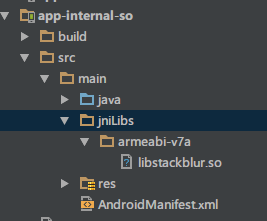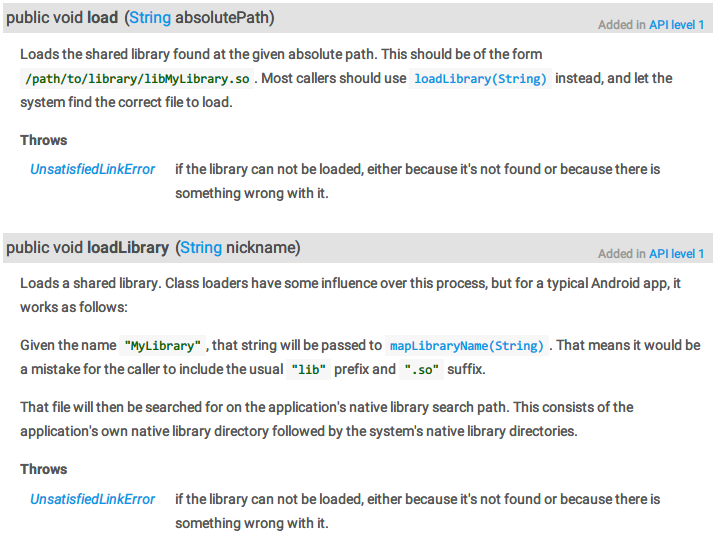Android中JNI的使用其实就包含了动态加载,APP运行时动态加载.so库并通过JNI调用其封装好的方法。后者一般是使用NDK工具从C/C++代码编译而成,运行在Native层,效率会比执行在虚拟机的Java代码高很多,所以Android中经常通过动态加载.so库来完成一些对性能比较有需求的工作(比如T9搜索、或者Bitmap的解码、图片高斯模糊处理等)。此外,由于.so库是由C++编译而来的,只能被反编译成汇编代码,相比Smali更难被破解,因此.so库也可以被用于安全领域。
与我们常说的基于ClassLoader的动态加载不同,SO库的加载是使用System类的(由此可见对SO库的支持也是Android的基础功能),所以这里这是作为补充说明。不过,如果使用ClassLoader加载SD卡里插件APK,而插件APK里面包含有SO库,这就涉及到了对插件APK里的SO库的加载,所以我们也要知道如何加载SD卡里面的SO库。
基本信息
一般的SO文件的使用姿势 以一个“图片高斯模糊”的功能为例,如果使用Java代码对图像Bitmap的每一个像素点进行计算,那整体耗时将会非常大,所以可以考虑使用JNI。(详细的JNI使用教程网络上有许多,这里不赘述)Android StackBlur
Text 命令就能编译出我们需要SO库
再把SO库复制到Android Studio项目的
Text 目录中
(Android Studio现在也支持直接编译SO库,但是有许多坑,这里我选择手动编译)
接着在Java中把SO库对应的模块加载进来
1 2 3 4 5 6 7 8 try { System.loadLibrary("stackblur" ); NativeBlurProcess.isLoadLibraryOk.set(true ); Log.i("MainActivity" , "loadLibrary success!" ); } catch (Throwable throwable) { Log.i("MainActivity" , "loadLibrary error!" + throwable); }
加载成功后就可以直接使用Native方法了
1 2 3 4 5 6 public class NativeBlurProcess public static AtomicBoolean isLoadLibraryOk = new AtomicBoolean(false ); private static native void functionToBlur (Bitmap bitmapOut, int radius, int threadCount, int threadIndex, int round) }
由此可见,在Android项目中,SO库的使用也是一种动态加载,在运行时把可执行文件加载进来。一般情况下,SO库都是打包在APK内部的,不允许修改这种“动态加载”看起来不是我们熟悉的那种啊,貌似没什么卵用。不过,其实SO库也是可以存放在外部存储路径的。
如何把SO文件存放在外部存储 注意到上面加载SO库的时候我们用到了System类的“loadLibrary”方法,同时我们也发现System类还有一个“load”方法,看起来差不多啊,看看他们有什么区别吧!
1 2 3 4 5 6 7 8 9 10 11 12 13 public static void load (String pathName) Runtime.getRuntime().load(pathName, VMStack.getCallingClassLoader()); } public static void loadLibrary (String libName) Runtime.getRuntime().loadLibrary(libName, VMStack.getCallingClassLoader()); }
先看看loadLibrary,这里调用了Runtime的loadLibrary,进去一看,又是动态加载熟悉的ClassLoader了(这里也佐证了SO库的使用就是一种动态加载的说法)
1 2 3 4 5 6 7 8 9 10 11 void loadLibrary (String libraryName, ClassLoader loader) if (loader != null ) { String filename = loader.findLibrary(libraryName); String error = doLoad(filename, loader); return ; } …… }
看样子就像是通过库名获取一个文件路径,再调用“doLoad”方法加载这个文件,先看看“loader.findLibrary(libraryName)”
1 2 3 protected String findLibrary (String libName) return null ; }
ClassLoader只是一个抽象类,它的大部分工作都在BaseDexClassLoader类中实现,进去看看
1 2 3 4 5 public class BaseDexClassLoader extends ClassLoader public String findLibrary (String name) throw new RuntimeException("Stub!" ); } }
不对啊,这里只是抛了一个RuntimeException异常,什么都没做啊!其实这里有一个误区 ,也是刚开始开Android SDK源码的同学容易搞混的。Android SDK自带的源码其实只是给我们开发者参考的,基本只是一些常用的类,Google不会把整个Android系统的源码都放到这里来,因为整个项目非常大,ClassLoader类平时我们接触得少,所以它的具体实现的源码并没有打包进SDK里,如果需要,我们要到官方AOSP项目里面去看(顺便一提,整个AOSP5.1项目大小超过150GB,真的有需要的话推荐用一个移动硬盘存储)。
这里为了方便,我们可以直接看在线的代码 BaseDexClassLoader.java
1 2 3 4 @Override public String findLibrary (String name) return pathList.findLibrary(name); }
再看进去DexPathList类
1 2 3 4 5 6 7 8 9 10 11 12 13 14 15 16 17 18 19 public String findLibrary (String libraryName) String fileName = System.mapLibraryName(libraryName); for (File directory : nativeLibraryDirectories) { File file = new File(directory, fileName); if (file.exists() && file.isFile() && file.canRead()) { return file.getPath(); } } return null ; }
到这里已经明朗了,根据传进来的libName,扫描APK内部的nativeLibrary目录,获取并返回内部SO库文件的完整路径filename。再回到Runtime类,获取filename后调用了“doLoad”方法,看看
1 2 3 4 5 6 7 8 9 10 11 12 13 private String doLoad (String name, ClassLoader loader) String ldLibraryPath = null ; String dexPath = null ; if (loader == null ) { ldLibraryPath = System.getProperty("java.library.path" ); } else if (loader instanceof BaseDexClassLoader) { BaseDexClassLoader dexClassLoader = (BaseDexClassLoader) loader; ldLibraryPath = dexClassLoader.getLdLibraryPath(); } synchronized (this ) { return nativeLoad(name, loader, ldLibraryPath); } }
到这里就彻底清楚了,调用Native方法“nativeLoad”,通过完整的SO库路径filename,把目标SO库加载进来。
说了半天还没有进入正题呢,不过我们可以想到,如果使用loadLibrary方法,到最后还是要找到目标SO库的完整路径,再把SO库加载进来,那我们能不能一开始就给出SO库的完整路径,然后直接加载进来?我们猜想load方法就是干这个的,看看。
1 2 3 4 5 6 7 8 9 void load (String absolutePath, ClassLoader loader) if (absolutePath == null ) { throw new NullPointerException("absolutePath == null" ); } String error = doLoad(absolutePath, loader); if (error != null ) { throw new UnsatisfiedLinkError(error); } }
我勒个去,一上来就直接来到doLoad方法了,这证明我们的猜想可能是正确的,那么在实际项目中测试看看吧!
我们先把SO放在Asset里,然后再复制到内部存储,再使用load方法把其加载进来。
1 2 3 4 5 6 7 8 9 10 11 12 13 14 15 16 17 18 19 20 21 22 23 24 25 26 27 28 29 30 31 32 33 34 35 36 37 38 39 40 41 42 43 44 45 46 public class MainActivity extends AppCompatActivity @Override protected void onCreate (Bundle savedInstanceState) super .onCreate(savedInstanceState); setContentView(R.layout.activity_main); File dir = this .getDir("jniLibs" , Activity.MODE_PRIVATE); File distFile = new File(dir.getAbsolutePath() + File.separator + "libstackblur.so" ); if (copyFileFromAssets(this , "libstackblur.so" , distFile.getAbsolutePath())){ System.load(distFile.getAbsolutePath()); NativeBlurProcess.isLoadLibraryOk.set(true ); } } public void onDoBlur (View view) ImageView imageView = (ImageView) findViewById(R.id.iv_app); Bitmap bitmap = BitmapFactory.decodeResource(getResources(), android.R.drawable.sym_def_app_icon); Bitmap blur = NativeBlurProcess.blur(bitmap,20 ,false ); imageView.setImageBitmap(blur); } public static boolean copyFileFromAssets (Context context, String fileName, String path) boolean copyIsFinish = false ; try { InputStream is = context.getAssets().open(fileName); File file = new File(path); file.createNewFile(); FileOutputStream fos = new FileOutputStream(file); byte [] temp = new byte [1024 ]; int i = 0 ; while ((i = is.read(temp)) > 0 ) { fos.write(temp, 0 , i); } fos.close(); is.close(); copyIsFinish = true ; } catch (IOException e) { e.printStackTrace(); Log.e("MainActivity" , "[copyFileFromAssets] IOException " +e.toString()); } return copyIsFinish; } }
点击onDoBlur按钮,果然加载成功了!
那能不能直接加载外部存储上面的SO库呢,把SO库拷贝到SD卡上面试试。
看起来是不可以的样子,Permission denied!
java.lang.UnsatisfiedLinkError: dlopen failed: couldn’t map “/storage/emulated/0/libstackblur.so” segment 1: Permission denied
看起来像是没有权限的样子,看看源码哪里抛出的异常吧
1 2 3 4 5 6 7 8 9 10 11 void load (String absolutePath, ClassLoader loader) if (absolutePath == null ) { throw new NullPointerException("absolutePath == null" ); } String error = doLoad(absolutePath, loader); if (error != null ) { } }
应该是执行doLoad方法时出现了错误,但是上面也看过了,doLoad方法里调用了Native方法“nativeLoad”,那应该就是Native代码里出现的错误。平时我很少看到Native里面,上一次看的时候,是因为需要看看点九图NinePathDrawable的缩放控制信息chunk数组的具体作用是怎么样,费了好久才找到我想要的一小段代码。所以这里就暂时不跟进去了,有兴趣的同学可以告诉我关键代码的位置。
我在一个Google的开发者论坛上找到了一些答案:
The SD Card is mounted noexec, so I’m not sure this will work. Moreover, using the SD Card as a storage location is a really bad idea, since any other application can modify/delete/corrupt it easily. Try downloading the library to your application’s data directory instead, and load it from here.
这也容易理解,SD卡等外部存储路径是一种可拆卸的(mounted)不可执行(noexec)的储存媒介,不能直接用来作为可执行文件的运行目录,使用前应该把可执行文件复制到APP内部存储再运行。
最后,我们也可以看看官方的API文档
看来load方法的用途和我们理解的一致,文档里说的shared library就是指SO库(shared object),至此,我们就可以把SO文件移动到外部存储了,或者从网络下载都行。




